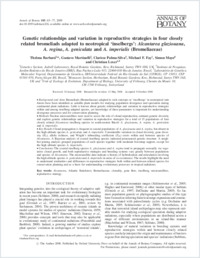Genetic diversity in Cypripedium calceolus (Orchidaceae) with a focus on north-western Europe, as revealed by plastid DNA length polymorphisms
- Fay, Michael F. Royal Botanic Gardens, Kew, Richmond, Surrey UK
- Bone, Ruth Royal Botanic Gardens, Kew, Richmond, Surrey UK
- Cook, Peter Royal Botanic Gardens, Kew, Richmond, Surrey UK
- Kahandawala, Imalka Royal Botanic Gardens, Kew, Richmond, Surrey UK - Birkbeck, University of London, UK
- Greensmith, Jennifer Royal Botanic Gardens, Kew, Richmond, Surrey UK
- Harris, Stacey Royal Botanic Gardens, Kew, Richmond, Surrey UK
- Pedersen, Henrik Æ. Botanical Garden & Museum, Natural History Museum of Denmark, University of Copenhagen, Denmark
- Ingrouille, Martin J. Birkbeck, University of London, UK
- Lexer, Christian Royal Botanic Gardens, Kew, Richmond, Surrey UK - University of Fribourg, Department of Biology, Unit of Ecology & Evolution, Switzerland
-
19.05.2009
Published in:
- Annals of Botany. - 2009, vol. 104, no. 3, p. 517-525
Biogeography
Cypripedium calceolus
genome size
plastid microsatellites
population genetics
seed dispersal
English
Background and Aims: Cypripedium calceolus, although widespread in Eurasia, is rare in many countries in which it occurs. Population genetics studies with nuclear DNA markers on this species have been hampered by its large nuclear genome size. Plastid DNA markers are used here to gain an understanding of variation within and between populations and of biogeographical patterns. Methods: Thirteen length- variable regions (microsatellites and insertions/deletions) were identified in non-coding plastid DNA. These and a previously identified complex microsatellite in the trnL-trnF intergenic spacer were used to identify plastid DNA haplotypes for European samples, with sampling focused on England, Denmark and Sweden. Key Results: The 13 additional length-variable regions identified were two homopolymer (polyA) repeats in the rps16 intron and a homopolymer (polyA) repeat and ten indels in the accD-psa1 intergenic spacer. In accD-psa1, most of these were in an extremely AT-rich region, and it was not possible to design primers in the flanking regions; therefore, the whole intergenic spacer was sequenced. Together, these new regions and the trnL-trnF complex microsatellite allowed 23 haplotypes to be characterized. Many were found in only one or a few samples (probably due to low sampling density), but some commoner haplotypes were widespread. Most of the genetic variation was found within rather than between populations (83 vs. 18%, respectively). Two haplotypes occurred from the Spanish Pyrenees to Sweden. Conclusions: Plastid DNA data can be used to gain an understanding of patterns of genetic variation and seed-mediated gene flow in orchids. Although these data are less information-rich than those for nuclear DNA, they present a useful option for studying species with large genomes. Here they support the hypothesis of long-distance seed dispersal often proposed for orchids.
- Faculty
- Faculté des sciences et de médecine
- Department
- Département de Biologie
- Language
-
- English
- Classification
- Botany
- License
- License undefined
- Identifiers
-
- RERO DOC 13115
- DOI 10.1093/aob/mcp116
- Persistent URL
- https://folia.unifr.ch/unifr/documents/301399
Statistics
Document views: 75
File downloads:
- Annals_of_Botany_2009.pdf: 125
